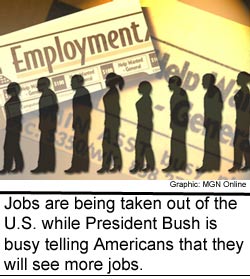
(FinalCall.coom) – Indentured servitude and slavery provided an essentially free labor force. As a result of the freedom and worker movements, these systems were eventually upgraded to wage slavery. Under this system, workers were paid minimal wages and worked long hours to acquire the bare essentials. Workers were forced to agree to labor to acquire various levels of food, lodging, education, health and transportation. The business owners reluctantly underwrote these essentials, primarily as a result of labor’s organized demand.
The emergence of powerful–sometimes corrupt unions–led to higher wages and benefits and forged out the American middle class. The middle class reaped rewards that soon allowed them to distance themselves from the underclass. However, as a result of the rising cost of American labor power-brokering, American companies organized to develop counter strategies.
The fifth World Trade Organization (WTO) Ministerial Conference was held in Cancun, Mexico September 10-14, 2003. Like past meetings, it was widely protested by individuals and international organizations around the world.
In opposition to the WTO, the International Forum on Globalization states: “The World Trade Organization is among the most powerful, and one of the most secretive international bodies on earth. It is rapidly assuming the role of global government, as 134 nation-states, including the U.S., have ceded to its vast authority and powers. The WTO represents the rules-based regime of the policy of economic globalization. The central operating principal of the WTO is that commercial interests should supersede all others. Any obstacles in the path of operations and expansion of global business enterprise must be subordinated. In practice these “obstacles” are usually policies or rights, social justice, local culture, and national sovereignty.”
Today, consistent with economic globalization policies, corporate America is either importing less-costly immigrant labor or shipping jobs out of America and into underdeveloped countries, where profits can be maximized. Jobs are being taken out of the U.S., while President Bush is busy telling Americans that they will see more jobs.
At the same time, he is pushing to reduce regulations on industry to increase overseas trade. And who do you really think is going to reap the benefits of any proposed tax relief? Government is coerced into fostering legislation that allows corporations to carry out their plans (i.e. The North America Trade Agreement, etc.). Hence, major corporations are downsizing their American workforce and at the same time exporting jobs into Mexico, Latin America, Taiwan, China, India, Russia and other parts of the world.
In an article that appeared in the August 1, 2003 edition of the Kansas City Star, Shashank Bengali suggested that the goal of a growing number of American companies is to outsource customer-service work to India, as a result of India’s low wages, thriving high-tech sector and annual output of two million English-speaking college graduates. A study by Forrester Research, a technology consulting group, estimates that 3.3 million white-collar service jobs will be outsourced to places like China, Russia and the Philippines–but more than half will go to India.
Indeed, it’s no accident that India, Pakistan and Turkey are among the countries that indicated a willingness to send troops to Iraq, provided the U.S. is able to gain UN approval.
Advocates of NAFTA assured Americans that their strength was really in the technical and service jobs–requiring people who are highly trained and highly educated. Now, those jobs are being threatened.
William Norman Grigg, in an article entitled “Exporting U.S. Jobs,” in The New American, September 22, 2003, addressed the impact of the loss of jobs on America’s laboring class. Millions of employees are being threatened with the loss of homes, cars and medical benefits. Several companies have been forced into bankruptcy as a result of not being able to compete with the movement of manufacturing businesses, from electronics to furniture, to China. According to the August 25, 2003 Financial Times, China is becoming the leading location for foreign investment, attracting $52.7 billion. Workers are being paid 50 cents an hour, which American industry cannot compete with. The American Textile Manufacturers Institute has pointed out that textiles from Communist China and Vietnam are flooding the American market. In 2008, all import quotas on Chinese textiles will be removed and the Chinese will completely dominate the market.
Since 1992, as many as 760,000 jobs have been lost due to the U.S.-China trade deficit. A comparative number of jobs have been sent to Mexico.
According to Mr. Grigg, the planned globalization movement’s ultimate goal is the eradication of the American middle class. It is the middle class that poses the greatest threat to the corporate/government plan for ultimate control, as the existence of two classes–the rich and the poor–is conducive to a dictatorship. The American middle class must now reassess what it has in common with the lower-class masses.
(Harry Davidson is co-chair of the Legislative Education Committee of the Association of Black Psychologists.)












